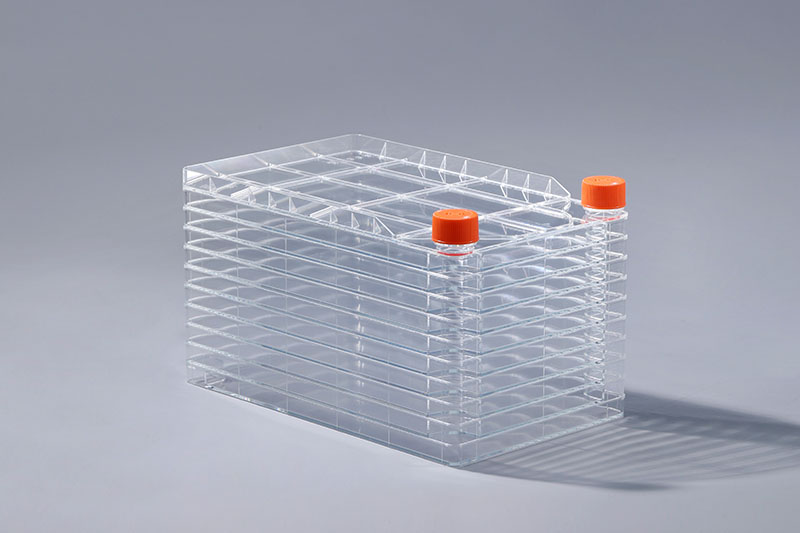में कोशिकाओं का संवर्धन करते समय माइकोप्लाज्मा संदूषण एक बहुत ही सामान्य समस्या है। अन्य संदूषणों के विपरीत, माइकोप्लाज्मा-दूषित कोशिकाएं आमतौर पर बादल नहीं बनती हैं, इसलिए नग्न आंखों से न्याय करना मुश्किल है। यह निर्धारित करने के चार तरीके हैं कि कोशिकाएं माइकोप्लाज्मा से दूषित हैं या नहीं:1. डीएनए फ्लोरेसेंस स्टेनिंगसेल फैक्ट्रियां
डीएनए फ्लोरेसेंस स्टेनिंग विधि इस सिद्धांत पर आधारित है कि फ्लोरोसेंट डाई Hoechst33258 माइकोप्लाज्मा के डीएनए में एटी बेस-रिच क्षेत्र से जुड़ सकती है। फ्लोरोसेंट डॉट्स माइकोप्लाज्मा डीएनए होते हैं जो एटी बेस क्षेत्रों में समृद्ध होते हैं।
2। पीसीआर तकनीक
विशिष्ट प्राइमरों को माइकोप्लाज्मा जीनोम में संरक्षित अनुक्रमों के अनुसार डिज़ाइन किया गया है, परीक्षण किए जाने वाले नमूने के न्यूक्लिक एसिड को बढ़ाया जाता है, और प्रवर्धित उत्पाद के आकार का विश्लेषण करके निदान किया जाता है। पीसीआर डिटेक्शन तकनीक का उपयोग छोटे चक्र, उच्च संवेदनशीलता, अच्छी विशिष्टता, सरल ऑपरेशन के साथ माइकोप्लाज्मा संदूषण का पता लगाने के लिए किया जाता है, और एक समय में बड़ी संख्या में नमूनों का पता लगा सकता है।
3। एंजाइम-लिंक्ड इम्युनोसॉरबेंट परख (एलिसा)
एलिसा का उपयोग अच्छी विशिष्टता और संवेदनशीलता के साथ माइकोप्लाज्मा संदूषण का पता लगाने में किया जाता है, और एक समय में बड़ी संख्या में नमूनों का पता लगाने में सक्षम है। इसमें सरल, तीव्र और मात्रात्मक गुणात्मक पहचान की विशेषताएं हैं।
4. इलेक्ट्रॉन माइक्रोस्कोप
आम तौर पर, सेल कारखानों में कोशिकाओं को 48 से 72 घंटों के लिए संवर्धित किया जाता है। इससे पहले कि कोशिकाएं करीब-करीब मिल जाती हैं, कोशिकाओं को ट्रिप्सिन के साथ पचाया जाता है ताकि एक सेल निलंबन, स्थिर, एम्बेडेड, और अवलोकन से पहले कटा हुआ हो।
सेल कारखानों में माइकोप्लाज्मा संदूषण का पता लगाने के लिए उपरोक्त चार सामान्य रूप से उपयोग की जाने वाली पहचान विधियां हैं। वर्तमान में, कोशिकाओं को दूषित करने के लिए ज्ञात 20 से अधिक प्रकार के माइकोप्लाज्मा हैं, जिनमें से 95% से अधिक मौखिक माइकोप्लाज्मा हैं, इसलिए कोशिकाओं को संवारने के दौरान ऑपरेटरों को सड़न रोकनेवाला ऑपरेशन पर ध्यान देना चाहिए।
The above are four commonly used detection methods when detecting mycoplasma contamination in cell factories. At present, there are more than 20 kinds of mycoplasma known to contaminate cells, of which more than 95% are oral mycoplasma, so operators should pay attention to aseptic operation when culturing cells.
The FAI climbed 5.9 percent year-on-year in the first 11 months of 2018, quickening from the 5.7-percent growth in Jan-Oct, the National Bureau of Statistics (NBS) said Friday in an online statement.
The key indicator of investment, dubbed a major growth driver, hit the bottom in August and has since started to rebound steadily.
In the face of emerging economic challenges home and abroad, China has stepped up efforts to stabilize investment, in particular rolling out measures to motivate private investors and channel funds into infrastructure.
Friday's data showed private investment, accounting for more than 60 percent of the total FAI, expanded by a brisk 8.7 percent.
NBS spokesperson Mao Shengyong said funds into weak economic links registered rapid increases as investment in environmental protection and agriculture jumped 42 percent and 12.5 percent respectively, much faster than the average.
In breakdown, investment in high-tech and equipment manufacturing remained vigorous with 16.1-percent and 11.6-percent increases respectively in the first 11 months. Infrastructure investment gained 3.7 percent, staying flat. Investment in property development rose 9.7 percent, also unchanged.
 English
English



















































